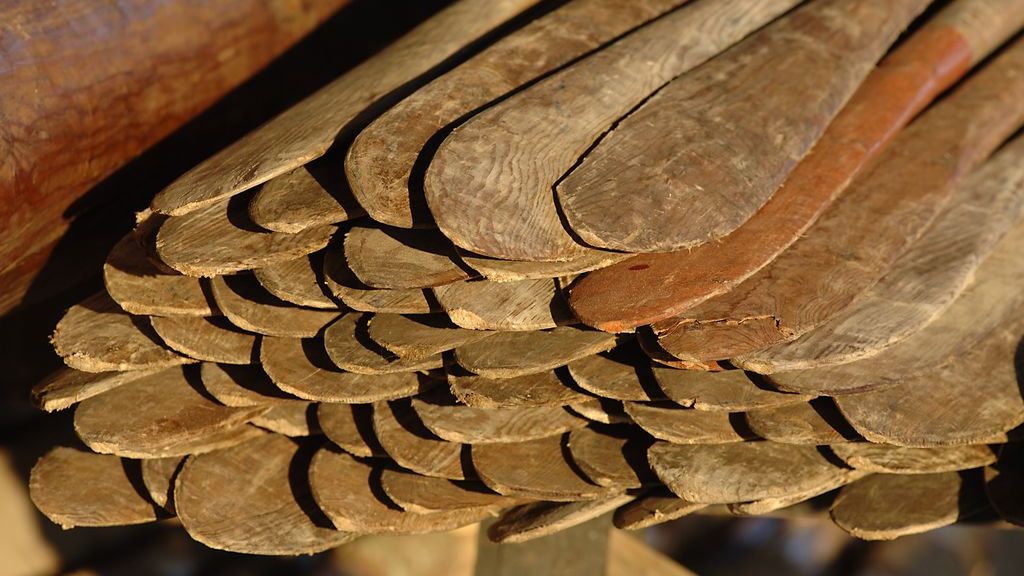The newly found Stone Age settlement, which dates to 6,000 BC, was discovered in June, in connection with the archaeological investigations related to the routing of the new sailing channel to Orehoved Harbour on the north coast of Falster. The actual archaeological excavations are on-going during the month of September.
8,000 year old hazelnuts that look like they were cracked yesterday
“During the initial test excavations, it quickly became obvious that this was a very important find”, tells museum curator and maritime archaeologist, Morten Johansen from the Viking Ship Museum. “The preservation conditions under the water are so good, that we’re finding the remnants of Stone Age daily life, which otherwise very rarely survive. It’s almost unbelievable to stand with a piece of worked wood that 8,000 years old, animal bones with traces of Stone Age craftsmens tools and hazelnuts that look like they were cracked yesterday”.
Today, the settlement lies under 5m of water. When the settlement was inhabited, the ocean level was much lower than it is today. The Ice Age was coming to an end and much of the ocean’s water was still trapped in the large ice caps to the north. Around 6,000 BC, the ice melted so quickly that the sea levels rose dramatically. The coastal settlements were flooded and afterwards buried under a protective layer of silt – a thick layer of organic material that spread over the settlement and the earlier coast, encapsulating the remains of past meals, tools, weapons, and people, in an oxygen-poor environment which has preserved the otherwise perishable remains for the last 8,000 years.
Dense forest, rushing rivers and deep valleys
Mesolithic people lived in a landscape dominated by dense forest, divided by rivers and wetlands, and settlements were often found near the coast – a coast which today, lies hidden several meters under the surface of the sea.
When the settlements were inhabited, Storstrømmen was a deep valley with running streams and wetlands and the maritime archaeologists find bears witness to the fact that people in the past lived on resources from both the forest and the sea.
The settlement is an important piece of a much larger puzzle: “We know very little about coastal settlements during this period, precisely because they’re now located under water. Therefore, the find we have made here, helps to fill in the gaps in our knowledge concerning Stone Age people’s exploitation of the surrounding environment and resources”, explains Morten Johansen. “We have a massive find of animal bones: everything from large mammals down to the smallest fish bones and scales. The bones give us an insight into the diet and hunting strategies of Stone Age hunters. Here at the settlement, their diet consisted of red deer, roe deer, wild boar, hazelnuts and fish. Some of the hunter’s prey has been quite a surprise – we’ve found traces of wild cat, water vole, hedgehog, otter, fox and beaver”
Excerpt from the archaeologists’ diary
“Oh my God! Oh my God!” The shouts interrupt the daily updates from project leader, Morten Johansen. “It’s massive!”
The shouts come across loud and clear, even though the telephone connection from the maritime archaeologists working platform off the coast in Storstrømmen isn’t the best in the world. “It’s a lump of amber the size of a chicken egg – it’s just come up – and it’s been worked, it has clear incisions and a drilled hole, I can’t talk more now – I’ll send photos!”
The mysterious pointed weapon
The archaeologists have raised more than 60 flint arrowheads and one larger fragment of the mystic ‘large projectile weapon’, which is characteristic of the Kongemose Culture. The pointed weapon from the excavation is unfortunately broken, and measures just 18cm, but it could have been 35-40cm long in its original form. ‘This isn’t an artefact you see often and is rarely found at settlement sites. The fact that we have found it in connection with a datable habitation layer is quite unique’, tells Morten Johansen.
For the maritime archaeologists, it’s not just the many rare finds that are exciting: they are looking for answers about the connection between earlier settlement discoveries in the area in order to gain a better understanding of Mesolithic settlement patterns.
“The new Storstrøms connection follows directly in the path of Stone Age people. Exactly here, at this point in Storstrømmen, has always been the perfect place to cross the straits between Falster and Sjælland, a fact that connects us with the people of the past” concludes Morten Johansen.
Background:
The reason for the maritime archaeological investigations is the construction of the new Storstrøm bridge: a 4km long bridge that will connect Sjælland and Falster via Masnedø, and which will replace the old bridge from 1937. The new bridge will cross an area where important finds have been made previously, and it is therefore routine that the maritime archaeological investigations will take place in the affected area.
- The submarine Stone Age settlement has been dated to the Villingebæk Phase of the Mesolithic Kongemose Period, ca. 6,000 BC.
- The settlement contains large quantities of rare Stone Age artefacts.
- Part of the settlement area has been protected by a silt-layer, which also includes the coastal margin with good preservation conditons for artefacts and organic material. This makes it possible to supplement our fragmentary understanding of coastal settlement during this period.
- Vejdirektoratet are responsible for the construction of the new Storstrøm Bridge, which will be Denmark’s 3rd largest bridge. The bridge is of great regional importance and is also an important part of the railway connection between Copenhagen and Germany. In the coming years, this connection will be strengthened even further with the establishment of the new line from Copenhagen to Ringsted and the forthcoming works with the Femern Belt connection.
- In all, the Storstrøm project is budgeted to cost 4.2 billion kroner.


